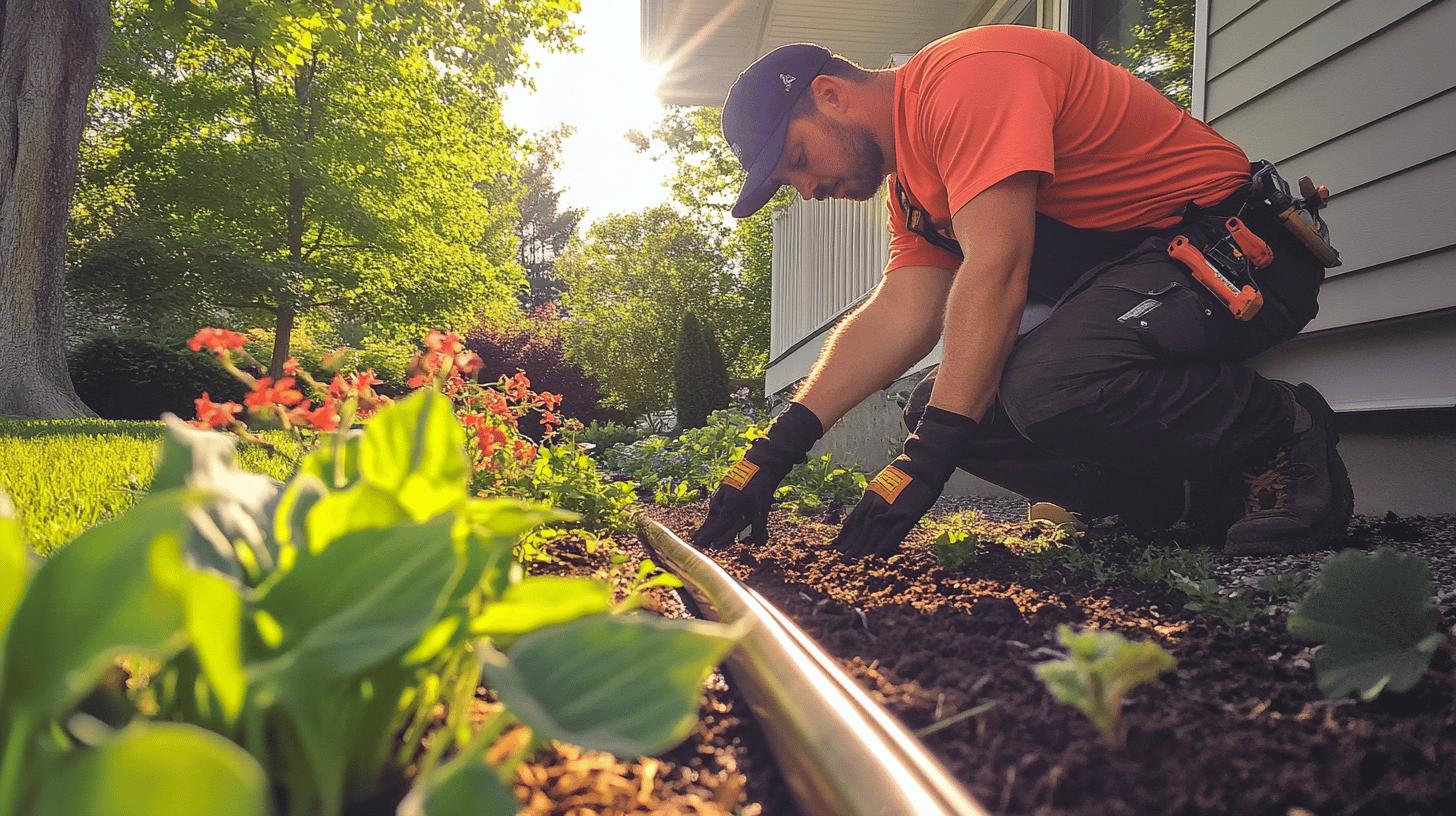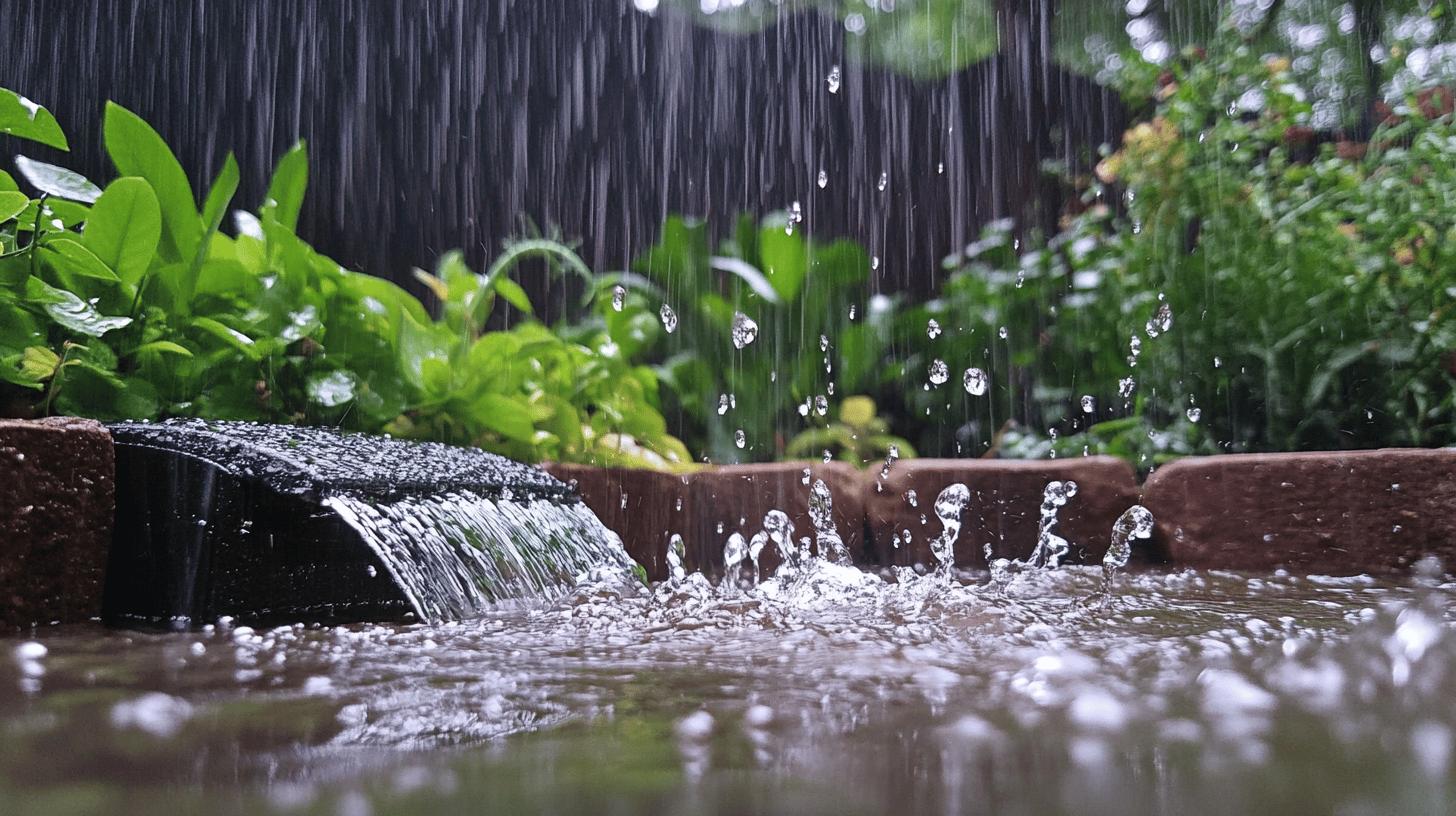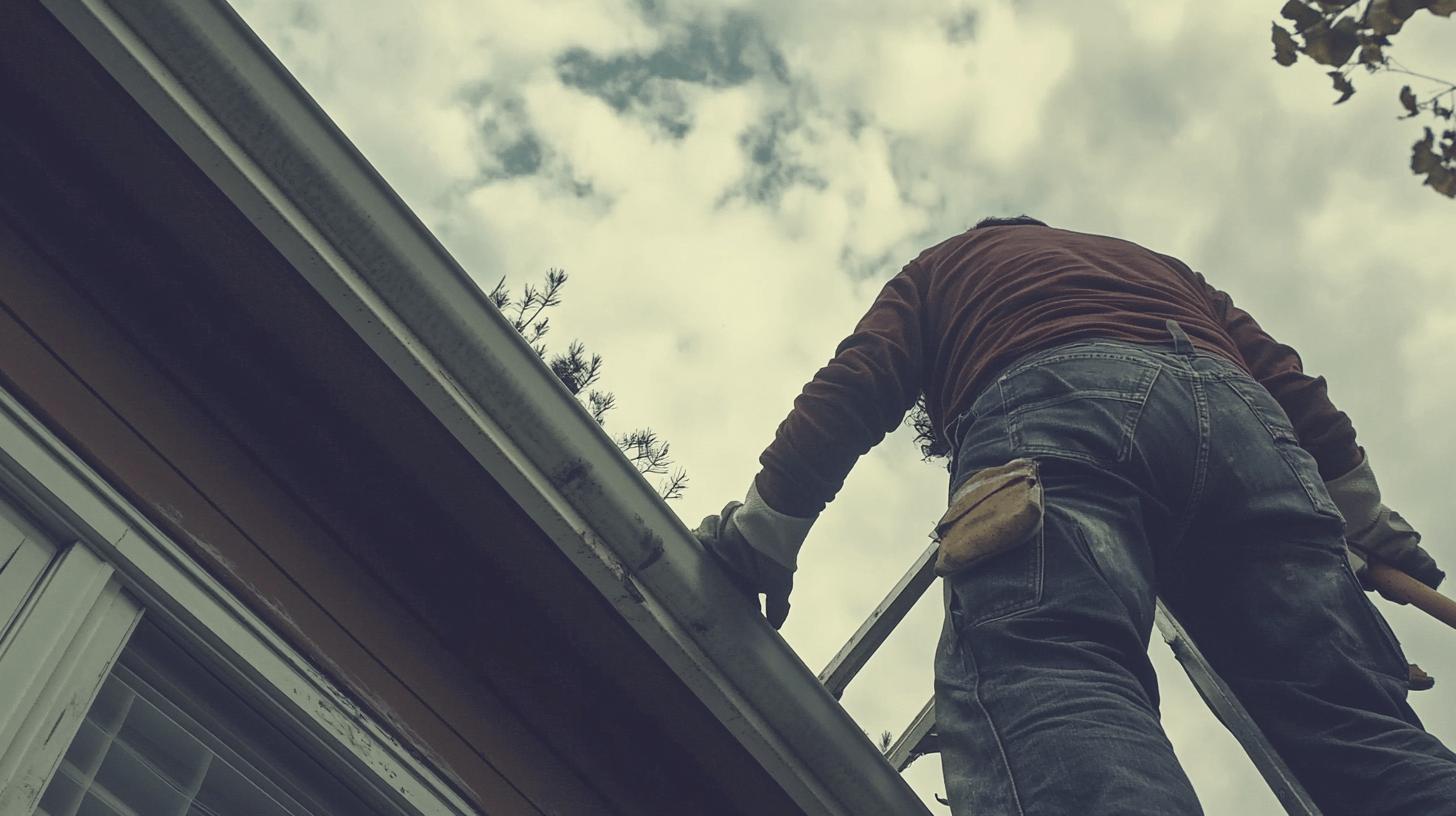TL;DR:
- Importance of Gutters: Protects homes from water damage by directing rainwater away.
- Issues from Poor Drainage: Foundation damage, mold growth, soil erosion, flooding, landscape damage.
- Downspout Extensions: Recommended 4-6 feet away; options include aluminum ($20-$30), roll-out ($15-$25), and flexible extensions ($10-$20).
- Underground Drainage: Uses 3-inch corrugated pipes, costs $50; pop-up emitters ($20) and inline catch basins ($30) help manage water.
- Maintenance: Regularly clean gutters; check for clogs and leaks; install gutter guards for ease.
- DIY vs. Professional: DIY saves costs but requires more maintenance; professionals ensure durability and precision.
Are your gutters doing their job, or are they putting your home’s foundation at risk every time it rains? Proper gutter drainage is about more than just moving water away; it’s about protecting your home from expensive water damage and foundation problems.
As you look for easy ways to make your gutters work better, you’ll find that a few simple steps can help prevent mold, soil erosion, and even flooding in your basement. By knowing how important gutters are and using some straightforward strategies, you can keep your home safe, no matter how heavy the rain gets.
Understanding the Importance of Proper Gutter Drainage
Gutters are essential for keeping your home safe from water damage. They collect rainwater and channel it away from your house, protecting the foundation. This setup stops water from pooling around your home, which can lead to serious structural problems over time. Good gutter drainage also prevents mold growth, which can happen when water seeps into walls and other materials. Regular maintenance and cleaning out debris help keep water flowing smoothly through the gutters, avoiding clogs and overflow.
Problems from poor gutter drainage include:
- Foundation damage
- Mold and mildew growth
- Soil erosion
- Basement flooding
- Landscape damage
Regular maintenance is key to keeping your gutters in good shape. Cleaning out leaves and debris helps water flow freely and reduces the risk of overflow. Installing gutter guards can also help keep debris from piling up, making maintenance easier and less frequent. By taking care of your gutters, you protect your home from water damage and maintain its structure and appearance.
Methods for Extending Downspouts

Downspout extensions are a simple and effective way to keep water away from your home’s foundation. By extending your downspouts 4 to 6 feet from the house, you can reduce the risk of foundation damage, basement flooding, and soil erosion. This easy fix helps protect your home and keeps your yard looking good. Directing water away from your foundation prevents costly repairs and maintains a dry, stable base.
When picking downspout extensions, there are plenty of options to fit different needs and budgets. Aluminum extensions are tough and weather-resistant, while roll-out sleeves extend during rain and retract when it’s dry for convenience. Flexible extensions let you direct water around obstacles like flower beds. Each type has its own benefits, so choose the one that works best for you.
- Aluminum extensions: $20-$30
- Roll-out sleeves: $15-$25
- Flexible extensions: $10-$20
Proper installation is key to making sure your downspout extensions work effectively. Start by measuring the right length so the extension directs water far enough away from your house. Make sure to securely attach the extension to the downspout to prevent leaks. Position the outlet at a slight downward angle to help the water flow smoothly. Don’t forget to check the connection and placement regularly to ensure everything is functioning well, and adjust as needed if your landscaping changes.
Installing Underground Drainage Systems
Underground drainage systems are great for handling rainwater runoff. They use corrugated pipes to slowly direct water away from your home, which helps prevent basement flooding and soil erosion. A 3-inch pipe usually does the trick for most homes, efficiently managing typical rainfall. Plus, these systems keep everything looking neat outside while protecting your landscape.
To get the best performance, start by planning the pipe route with a slight slope (about 1%) for water flow. Dig a trench along this path deep enough for the 3-inch pipe, and install a pop-up emitter at the end to safely release water on the surface.
Make sure to connect the pipe to the downspout using secure fittings to avoid leaks. After that, cover the trench and pipe with soil, leaving the emitter exposed. This way, your yard looks good while still directing water away from problem areas.
Regular maintenance is key to keeping the drainage system running well. Check it periodically for clogs or debris, as blockages can disrupt water flow. You can flush the pipes with water to clear out any debris and use a vented cleanout for easier access. Keeping everything in good shape will help protect your home from water damage.
| Material | Cost | Use |
|———————-|——|—————————-|
| Corrugated Pipe | $50 | Main water transport |
| Pop-up Emitter | $20 | Surface water discharge |
| Inline Catch Basin | $30 | Debris collection and removal |
Utilizing Splash Blocks and Other Surface Solutions

Splash blocks are a simple and effective way to handle water runoff around your home. Positioned at the base of downspouts, they help guide water away from your foundation, preventing it from pooling and causing damage. Their straightforward design makes them perfect for DIY homeowners who want to protect their property without needing professional help. By directing water away properly, splash blocks keep your foundation dry and reduce the chances of water-related problems.
- Splash blocks
- Gutter diverters
- Rain gardens
- Roll-out drain sleeves
To make sure splash blocks work well, install them on a stable, level surface so they don’t shift. It’s also important to regularly clean off any debris that might block water flow. For more control over water direction, you can use gutter diverters. If you want a nice-looking solution, adding rain gardens can help absorb extra water. Roll-out drain sleeves are another great option, as they extend the reach of downspouts, directing water even further away from your home. All these options can improve how effectively splash blocks manage water around your property.
Professional vs. DIY Gutter Drainage Solutions
Hiring professionals for gutter drainage has many advantages, especially when it comes to safety and secure installation. Experts know how to choose the right materials and techniques to ensure gutters effectively direct water, which reduces the risk of leaks, clogs, or improper angles that can lead to water damage. They can also handle more complex installations, like underground drainage systems, with precision, providing long-lasting solutions.
On the other hand, DIY options can be great if you’re trying to save money and want to take a hands-on approach. For example, roll-out sleeves are a cost-effective way to extend downspouts without needing a pro. While these materials are easy to find, DIY solutions might not be as durable as professional installations and may require more frequent maintenance.
- Cost-effectiveness
- Ease of installation
- Accessibility of materials
When deciding between hiring professionals and going the DIY route for your gutter drainage, think about your budget, how complicated the drainage work is, and how comfortable you are with DIY projects. If you have a lot of extensive work to do or prefer not to get your hands dirty, it might be better to hire professionals. However, if you’re confident in your skills and want to save some money, a DIY approach could work well for you. Assess your specific needs to figure out the best option for an effective gutter system.
Maintenance and Troubleshooting Tips for Gutter Systems

Regular maintenance is key to keeping your gutters in good shape and preventing downspout problems. Make sure to clean out leaves and debris regularly to avoid clogs and water damage. Installing gutter guards can help reduce buildup, making maintenance easier. For underground drainage systems, using a vented cleanout provides easy access for cleaning and keeps water flowing smoothly. By staying on top of gutter care, you can lower the risk of clogs and improve the overall performance of your drainage system.
- Clogs and blockages: Clear debris regularly for water flow.
- Leaks and overflows: Seal gaps and check connections.
- Improper drainage angle: Adjust downspouts for correct flow.
- Damaged downspouts: Look for dents or cracks; repair or replace.
- Debris accumulation: Use guards to reduce leaves and dirt buildup.
Professional maintenance provides extra advantages for your gutters. Experts can tackle complicated problems like improper angles or damaged components more effectively than a DIY approach. With the right tools and know-how, they can perform thorough cleanings to keep your system running smoothly. Investing in professional maintenance saves you time and helps your gutters last longer, reducing the chances of expensive repairs down the line.
Final Words
Good gutter drainage is essential for keeping your home safe from expensive water damage. By controlling where water flows, you can avoid foundation problems, mold, and issues with your landscaping. Options like extending downspouts and installing underground drainage systems work well. Simple solutions like splash blocks can also help direct water away from your home.
Whether you go the DIY route or hire professionals, it’s important to keep your system running efficiently. Regular maintenance and quick fixes are crucial for keeping your drainage system in good shape.
By knowing how to manage gutter drainage effectively, you can protect your home and enjoy peace of mind.
FAQ
How to drain gutters away from the house underground?
To drain gutters away from your house underground, install a corrugated pipe with a 1% slope. Use a catch basin and pop-up emitter to allow water dispersal.
How do you run a gutter drain away from your house?
Run a gutter drain away by attaching downspout extensions. Aluminum and flexible options help direct water 4 to 6 feet from your foundation.
How far away from the house should gutters drain?
Gutters should ideally drain water at least 4 to 6 feet away from the house to prevent foundation damage and other water-related issues.
How to divert water runoff away from a house?
To divert water runoff, use splash blocks, gutter diverters, or rain gardens. These solutions manage surface drainage and keep water from pooling near your foundation.
What are some ideas to drain water away from the house?
Some effective ideas include installing splash blocks, creating a rain garden, and using roll-out sleeves or underground systems to redirect water flow.
What are downspout drainage options?
Downspout drainage options include aluminum extensions, roll-out sleeves, flexible downspout extensions, and underground drainage systems with corrugated pipes.
How do underground gutter drainage systems work?
Underground gutter systems use corrugated pipes to slowly release water away from a house. They require proper installation with a slight slope and a pop-up emitter.
What is the meaning of gutter drainage?
Gutter drainage refers to the system that channels rainwater from the roof through gutters, downspouts, and extensions to protect the home’s foundation by moving water away effectively.

